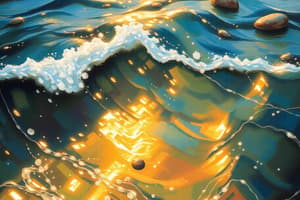Podcast
Questions and Answers
Why does light change direction when passing from air into glass?
Why does light change direction when passing from air into glass?
- The speed of light changes. (correct)
- The frequency of light changes.
- The intensity of light increases.
- The amplitude of light changes.
What is the role of the 'normal' in the context of refraction?
What is the role of the 'normal' in the context of refraction?
- It is a line parallel to the surface.
- It is a measure of the light's intensity.
- It is the path the light ray takes.
- It is a reference line perpendicular to the surface. (correct)
According to Snell's Law, what remains constant when light refracts?
According to Snell's Law, what remains constant when light refracts?
- The angle of incidence.
- The angle of refraction.
- The ratio of sines of angles and refractive indices. (correct)
- The speed of light.
If light travels from water (n=1.33) into air (n=1.00), how does it bend?
If light travels from water (n=1.33) into air (n=1.00), how does it bend?
How do prisms use refraction to create a rainbow?
How do prisms use refraction to create a rainbow?
What phenomenon explains how optical fibers transmit light signals over long distances?
What phenomenon explains how optical fibers transmit light signals over long distances?
What property of light is defined as the distance between two successive crests of a light wave?
What property of light is defined as the distance between two successive crests of a light wave?
Which color of light corresponds to shorter wavelengths?
Which color of light corresponds to shorter wavelengths?
In the context of soundscapes, what indirect influence can light have?
In the context of soundscapes, what indirect influence can light have?
How might bright environments affect human perception of sound?
How might bright environments affect human perception of sound?
How does the speed of light in a medium relate to its refractive index?
How does the speed of light in a medium relate to its refractive index?
Why is the refractive index of a medium always greater than or equal to 1?
Why is the refractive index of a medium always greater than or equal to 1?
If a light ray strikes a surface at an angle of incidence of 0 degrees, what is the angle of refraction?
If a light ray strikes a surface at an angle of incidence of 0 degrees, what is the angle of refraction?
A beam of white light is shone through a prism. Which color of light bends the most, and why?
A beam of white light is shone through a prism. Which color of light bends the most, and why?
How does the wave nature of light explain the phenomenon of diffraction?
How does the wave nature of light explain the phenomenon of diffraction?
What happens to the frequency of light when it passes from air into glass?
What happens to the frequency of light when it passes from air into glass?
Which of the following is NOT a direct application of refraction?
Which of the following is NOT a direct application of refraction?
How does an increase in the frequency of light affect its wavelength?
How does an increase in the frequency of light affect its wavelength?
What is the primary reason optical fibers can transmit light signals with minimal loss?
What is the primary reason optical fibers can transmit light signals with minimal loss?
Considering Snell's Law, under what conditions would total internal reflection occur?
Considering Snell's Law, under what conditions would total internal reflection occur?
How does the amplitude of a light wave relate to its perceived brightness?
How does the amplitude of a light wave relate to its perceived brightness?
In scenarios where both light and sound are present, how might lighting conditions alter an individual's perception of sound, according to the concept of soundscapes?
In scenarios where both light and sound are present, how might lighting conditions alter an individual's perception of sound, according to the concept of soundscapes?
How does the phenomenon of refraction contribute to the ability of lenses to focus light?
How does the phenomenon of refraction contribute to the ability of lenses to focus light?
A light ray travels from air (n=1.0) into a transparent substance with n=1.5. If the angle of incidence is 30 degrees, what is the approximate angle of refraction?
A light ray travels from air (n=1.0) into a transparent substance with n=1.5. If the angle of incidence is 30 degrees, what is the approximate angle of refraction?
In the context of soundscapes and light interaction, how can strategic architectural lighting influence auditory comfort and perception within a space?
In the context of soundscapes and light interaction, how can strategic architectural lighting influence auditory comfort and perception within a space?
If the speed of light in a certain medium is 2.0 x $10^8$ m/s, what is the refractive index of the medium?
If the speed of light in a certain medium is 2.0 x $10^8$ m/s, what is the refractive index of the medium?
Which statement best describes how light behaves according to its wave-particle duality?
Which statement best describes how light behaves according to its wave-particle duality?
Assuming identical angles of incidence, which medium will exhibit the smallest angle of refraction if light is entering from air?
Assuming identical angles of incidence, which medium will exhibit the smallest angle of refraction if light is entering from air?
How does the wavelength of red light compare to the wavelength of blue light in a vacuum?
How does the wavelength of red light compare to the wavelength of blue light in a vacuum?
If a person perceives that particular sound frequencies are amplified or altered in presence of intense lighting, what aspect of soundscape and light interaction is applicable?
If a person perceives that particular sound frequencies are amplified or altered in presence of intense lighting, what aspect of soundscape and light interaction is applicable?
What is the function of the 'normal' in the laws of refraction, and why is it important?
What is the function of the 'normal' in the laws of refraction, and why is it important?
Flashcards
What is light?
What is light?
Electromagnetic radiation exhibiting wave-like behavior and interacts with matter.
What is refraction?
What is refraction?
Light bends as it passes from one medium to another, due to changes in speed.
What are the laws of refraction?
What are the laws of refraction?
States incident ray, refracted ray, and normal lie in the same plane; Snell's Law relates refractive indices and angles.
What is Snell's Law?
What is Snell's Law?
Signup and view all the flashcards
What is refractive index?
What is refractive index?
Signup and view all the flashcards
What is 'the normal'?
What is 'the normal'?
Signup and view all the flashcards
What do lenses do?
What do lenses do?
Signup and view all the flashcards
What do prisms do?
What do prisms do?
Signup and view all the flashcards
What do optical fibers do?
What do optical fibers do?
Signup and view all the flashcards
What is wavelength?
What is wavelength?
Signup and view all the flashcards
What is frequency?
What is frequency?
Signup and view all the flashcards
What is amplitude?
What is amplitude?
Signup and view all the flashcards
Speed of light equation
Speed of light equation
Signup and view all the flashcards
What is a soundscape?
What is a soundscape?
Signup and view all the flashcards
Study Notes
- Light is a form of electromagnetic radiation that exhibits wave-like behavior and interacts with matter.
Light Properties
- Light travels in straight lines.
- Light can be reflected, refracted, and diffracted.
- Light carries energy.
- Light has a dual nature, behaving as both a wave and a particle (photon).
- The speed of light in a vacuum is a fundamental constant, approximately 299,792,458 meters per second.
- Light has properties, such as intensity, wavelength and frequency.
Refraction
- Bending of light as it passes from one medium to another due to a change in speed.
- It occurs when light travels through different mediums with varying densities.
- The change in speed of light causes it to bend, altering its direction.
- Refraction is responsible for optical illusions like mirages and the apparent bending of objects submerged in water.
- Refraction is the reason lenses can focus light.
Laws of Refraction
- The incident ray, the refracted ray, and the normal to the surface at the point of incidence all lie in the same plane.
- Snell's Law: Describes the relationship between the angles of incidence and refraction, and the refractive indices of the two media.
- Snell's Law is expressed as: n1 * sin(θ1) = n2 * sin(θ2), where: n1 and n2 are the refractive indices of the two media, θ1 is the angle of incidence, θ2 is the angle of refraction.
- The refractive index of a medium is the ratio of the speed of light in a vacuum to the speed of light in the medium.
- When light travels from a less dense medium to a denser medium, it bends towards the normal.
- When light travels from a denser medium to a less dense medium, it bends away from the normal.
Normal Ray's
- The "normal" is an imaginary line perpendicular to the surface at the point where the light ray strikes the surface.
- Angles of incidence and refraction are measured with respect to the normal.
- The angle of incidence is the angle between the incident ray and the normal.
- The angle of refraction is the angle between the refracted ray and the normal.
Applications of Refraction
- Lenses in eyeglasses, cameras, and telescopes use refraction to focus light and form images.
- Prisms use refraction to separate white light into its constituent colors (dispersion).
- Optical fibers rely on total internal reflection (a consequence of refraction) to transmit light over long distances.
- The human eye uses refraction to focus light onto the retina, allowing us to see.
- Atmospheric refraction causes mirages and the apparent flattening of the sun at sunset.
Wave Behavior of Light
- Light exhibits wave-like properties, including wavelength, frequency, and amplitude.
- Wavelength is the distance between two successive crests or troughs of a light wave.
- Frequency is the number of wave cycles that pass a given point per unit time.
- Amplitude is the maximum displacement of the wave from its equilibrium position.
- The relationship between wavelength (λ), frequency (f), and the speed of light (c) is given by: c = λ * f.
- Different wavelengths of light correspond to different colors; for example, shorter wavelengths correspond to blue and violet, while longer wavelengths correspond to red and orange.
Soundscapes and Light Interaction
- The term "soundscape" usually refers to the total collection of sounds in a particular environment.
- While soundscapes primarily deal with auditory experiences, light can indirectly influence them.
- Light can affect the behavior of animals, including their vocalizations, thus influencing the soundscape.
- Light influences human perception of sound and bright environments may increase sensitivity to certain sounds.
- In architectural acoustics, lighting design can complement sound design to create a holistic sensory experience.
Studying That Suits You
Use AI to generate personalized quizzes and flashcards to suit your learning preferences.




